Snails from the superfamily Cypraeoidea generally have smooth shells and mature snails usually lack an operculum and have a narrow aperture. They keep their shells smooth by enclosing them in their mantle, which prevents other organisms like algae or barnacles from growing on them. At the same time, the mantle protects the shell from abrasion, and repairs the shell if there are damages. The smooth shell makes it hard for predators to have a good grip, and the snail will retract into the shell when threatened.
This superfamily is represented by two families in Singapore: Cypraeidae and Ovulidae. You may want to take a look at my diagram on the parts of a snail's shell if you are not familiar with the names of the parts, so as to better understand the terms used below.
Family Cypraeidae
Commonly known as cowries (singular cowrie or cowry), snails from this family have smooth and glossy egg-shaped shells. Some may come with intricate patterns, while others may be very plain. They have a narrow aperture, with teeth along the sides, which makes it difficult for predators to reach the snail within the shell. The mantle often also has protrusions or dull colours to enable the snail to camouflage. Due to their smooth and pretty shells, many cowries are collected to make into decorative items, resulting in the over-collection of some of the more attractive species in some localities. Previously, most of the species were assigned to the genus Cypraea, but in recent revisions they were divided into more genera.

The Arabian Cowrie (Mauritia arabica), growing to about 8cm long, is one of the larger cowrie that can be found in local waters. It can be found near corals, or in rocky areas near coral reefs. The shell is marked with numerous brown lines and dots, interrupted by gaps.

Like other cowries, it has a narrow aperture. The lips are marked with brown line-like teeth that are longer in the middle.

The Millet Cowrie (Erosaria miliaris) got its common name from the numerous spots on its shell, appearing like millet seeds. To be precise, "miliaris", in Middle English, actually refers to a skin disease characterised by small lesions resembling millet seeds. I have seen in sandy-mud substrates, usually clinging onto hard surfaces. The biggest I have seen is about 4cm long.

The mantle has numerous protruding structures, probably for camouflage purposes.

The Four-spotted Cowrie (Eclogavena quadrimaculata) appears to be seasonal, as there are times when they are regularly seen over several trips, but yet none can be found at other times. It has two dark brown spots at each end, and grows to about 3cm long. It can be found near coral reefs, sometimes under rocks or coral rubble.

Here's a look of the underside.
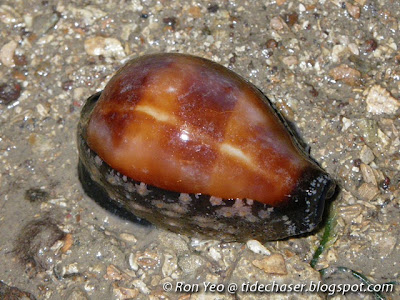
The Onyx Cowrie (Erronea onyx) is commonly seen at sandy-mud areas, usually clinging to hard surfaces. The brown coloured shell is marked with darker spiral bands, and often two milky strips can be seen running across the body whorl. The biggest I have seen is about 4cm long.

The mantle can be rather variable - this one is whitish in colour.

Sometimes, the mantle can be black or a dark grey.
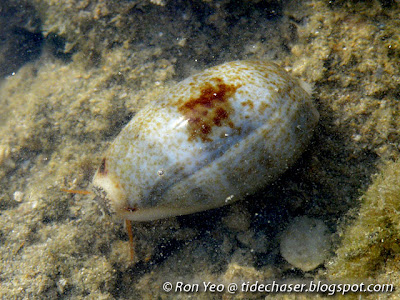
The Wandering Cowrie (Erronea errones) is one of the commonest cowries on our shores, especially in areas near coral reefs. I have seen them on rocky shores, among sponges, and under coral rubble. They grow to about 2.5cm long, and usually have brown stains near the front or back end of their shells. Sometimes, the top of the shell is marked with a dark brown patch.

Here's a look at the Wandering Cowrie with its mantle extended over the shell.
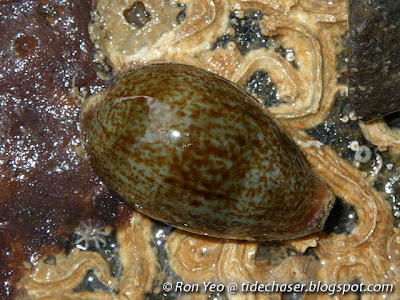
The Ovum Cowrie (Erronea ovum) is yet another very common cowrie, usually found under rocks in the day, emerging to feed at night. It lacks the brown stains at the front and back ends, and also does not have a brown patch on the top of its shell.

The colour of the shell may vary from a brownish colour to whitish with brown specks.

On the underside, the space between the teeth (some or all) may or may not have some orange stains.
Apart from the cowries above which I have photographed in Singapore, there are a few other cowries which are recorded from Singapore, but I have only photographed them in Malaysia and Indonesia. Below are some of them:

The Lynx Cowrie (Lyncina lynx) is a large snail, growing to about 8cm long. The colour is quite variable, but the shells are mostly yellowish brown with numerous small sots and several bigger spots, often with a milky glaze. Sometimes, a darker band runs across the body whorl in the middle. It can be mistaken for the bigger Tiger Cowrie sometimes, though the latter has more equally sized spots on its shell. The above photo was taken on Pulau Tioman.
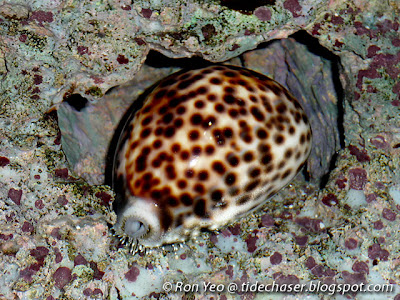
The Tiger Cowrie (Cypraea tigris) is seldom seen in Singapore as well, though several of my friends have seen it before. The above photo was taken at an aquarium. This large cowrie can grow to about 15cm long. The back of the shell is marked with roundish spots, usually dark brown or black in colour.

The Pacific Deer Cowrie (Lyncina vitellus) grows to about 6cm long. The shell somewhat resembles those of the Millet Cowrie, but is more reddish brown and with fewer scattered white spots. This photo was also taken on Pulau Tioman, in a rocky area near a coral reef.

This Gold-ringer Cowrie (Monetaria annulus) was photographed in Bali in a coral rubble area near a coral reef. It has a somewhat circular yellow band on its shell.
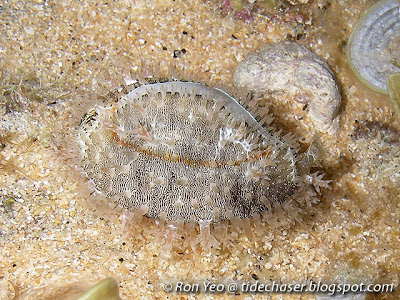
Here's a Gold-ringer Cowrie with the mantle extended, photographed on Pulau Tioman. It can grow to about 2cm long.

The Money Cowrie (Monetaria moneta) is very rarely seen in Singapore. This picture was taken in Bali in a coral rubble area near a coral reef. The shell is somewhat cream-coloured with greyish bands or stains, and can get to about 2.5cm long. It sometimes has a faint yellow ring on the shell as well, somewhat resembling the ones on the Gold-ringer Cowrie.

The Mole Cowrie (Talparia talpa) is also recorded from Singapore, but I have not seen it here yet. The above photo was taken on Pulau Tioman. The shell is brown in colour, often with darker bands. The margins of the shell are black or a very dark brown. It can get to about 7cm long.
Family Ovulidae
The ovulids, or egg cowries, are closely related to the cowries. Like the latter, they also have smooth and glossy shells, and they can enclose their shells with their mantle. They, however, lack the teeth along their apertures. Depending on the species, they can be egg-shaped or spindle-shaped. They are usually found living on corals and gorgonians, feeding on the polyps of these animals. Many of these snails have colours or patterns similar to their hosts for camouflage purposes.

A number of spindle cowries can be found on sea fans. The above is a Crenavolva sp. - the exact species can be determined only by a close examination of the shell. It is somewhat ovate, and the colour ranges from yellowish to dark red, depending on the sea fan it is on.

The above features another Crenavolva sp. with a slightly different-shaped shell.

The above features another type of spindle cowries, Phenacovolva sp. I am not sure if both snails are of the same species. The bigger one appeared to be laying a row of eggs on the sea fan though.

The above is another Phenacovolva sp. with a white shell and white mantle marked with black and yellow spots.

The Alabaster Egg Cowrie (Diminovula alabaster) is usually found on soft corals from the family Nephtheidae. There is a yellow line running along the margins of the shell, and the mantle is white and marked with greyish or pinkish blotches with darker outlines.

The foot is white with several black or dark grey lines.

The Umbilical Egg Shell (Calpurnus verrucosus) is recorded from Singapore, but has not been seen in recent years. The above photo was taken in Pulau Tioman. The shell is white, with a button-like structure and pinkish stains on both ends. The mantle is white with small black spots. It is usually found on soft corals.
References
This superfamily is represented by two families in Singapore: Cypraeidae and Ovulidae. You may want to take a look at my diagram on the parts of a snail's shell if you are not familiar with the names of the parts, so as to better understand the terms used below.
Family Cypraeidae
Commonly known as cowries (singular cowrie or cowry), snails from this family have smooth and glossy egg-shaped shells. Some may come with intricate patterns, while others may be very plain. They have a narrow aperture, with teeth along the sides, which makes it difficult for predators to reach the snail within the shell. The mantle often also has protrusions or dull colours to enable the snail to camouflage. Due to their smooth and pretty shells, many cowries are collected to make into decorative items, resulting in the over-collection of some of the more attractive species in some localities. Previously, most of the species were assigned to the genus Cypraea, but in recent revisions they were divided into more genera.

The Arabian Cowrie (Mauritia arabica), growing to about 8cm long, is one of the larger cowrie that can be found in local waters. It can be found near corals, or in rocky areas near coral reefs. The shell is marked with numerous brown lines and dots, interrupted by gaps.

Like other cowries, it has a narrow aperture. The lips are marked with brown line-like teeth that are longer in the middle.

The Millet Cowrie (Erosaria miliaris) got its common name from the numerous spots on its shell, appearing like millet seeds. To be precise, "miliaris", in Middle English, actually refers to a skin disease characterised by small lesions resembling millet seeds. I have seen in sandy-mud substrates, usually clinging onto hard surfaces. The biggest I have seen is about 4cm long.

The mantle has numerous protruding structures, probably for camouflage purposes.

The Four-spotted Cowrie (Eclogavena quadrimaculata) appears to be seasonal, as there are times when they are regularly seen over several trips, but yet none can be found at other times. It has two dark brown spots at each end, and grows to about 3cm long. It can be found near coral reefs, sometimes under rocks or coral rubble.

Here's a look of the underside.

The Onyx Cowrie (Erronea onyx) is commonly seen at sandy-mud areas, usually clinging to hard surfaces. The brown coloured shell is marked with darker spiral bands, and often two milky strips can be seen running across the body whorl. The biggest I have seen is about 4cm long.

The mantle can be rather variable - this one is whitish in colour.

Sometimes, the mantle can be black or a dark grey.

The Wandering Cowrie (Erronea errones) is one of the commonest cowries on our shores, especially in areas near coral reefs. I have seen them on rocky shores, among sponges, and under coral rubble. They grow to about 2.5cm long, and usually have brown stains near the front or back end of their shells. Sometimes, the top of the shell is marked with a dark brown patch.

Here's a look at the Wandering Cowrie with its mantle extended over the shell.

The Ovum Cowrie (Erronea ovum) is yet another very common cowrie, usually found under rocks in the day, emerging to feed at night. It lacks the brown stains at the front and back ends, and also does not have a brown patch on the top of its shell.

The colour of the shell may vary from a brownish colour to whitish with brown specks.

On the underside, the space between the teeth (some or all) may or may not have some orange stains.
Apart from the cowries above which I have photographed in Singapore, there are a few other cowries which are recorded from Singapore, but I have only photographed them in Malaysia and Indonesia. Below are some of them:

The Lynx Cowrie (Lyncina lynx) is a large snail, growing to about 8cm long. The colour is quite variable, but the shells are mostly yellowish brown with numerous small sots and several bigger spots, often with a milky glaze. Sometimes, a darker band runs across the body whorl in the middle. It can be mistaken for the bigger Tiger Cowrie sometimes, though the latter has more equally sized spots on its shell. The above photo was taken on Pulau Tioman.

The Tiger Cowrie (Cypraea tigris) is seldom seen in Singapore as well, though several of my friends have seen it before. The above photo was taken at an aquarium. This large cowrie can grow to about 15cm long. The back of the shell is marked with roundish spots, usually dark brown or black in colour.

The Pacific Deer Cowrie (Lyncina vitellus) grows to about 6cm long. The shell somewhat resembles those of the Millet Cowrie, but is more reddish brown and with fewer scattered white spots. This photo was also taken on Pulau Tioman, in a rocky area near a coral reef.

This Gold-ringer Cowrie (Monetaria annulus) was photographed in Bali in a coral rubble area near a coral reef. It has a somewhat circular yellow band on its shell.

Here's a Gold-ringer Cowrie with the mantle extended, photographed on Pulau Tioman. It can grow to about 2cm long.

The Money Cowrie (Monetaria moneta) is very rarely seen in Singapore. This picture was taken in Bali in a coral rubble area near a coral reef. The shell is somewhat cream-coloured with greyish bands or stains, and can get to about 2.5cm long. It sometimes has a faint yellow ring on the shell as well, somewhat resembling the ones on the Gold-ringer Cowrie.

The Mole Cowrie (Talparia talpa) is also recorded from Singapore, but I have not seen it here yet. The above photo was taken on Pulau Tioman. The shell is brown in colour, often with darker bands. The margins of the shell are black or a very dark brown. It can get to about 7cm long.
Family Ovulidae
The ovulids, or egg cowries, are closely related to the cowries. Like the latter, they also have smooth and glossy shells, and they can enclose their shells with their mantle. They, however, lack the teeth along their apertures. Depending on the species, they can be egg-shaped or spindle-shaped. They are usually found living on corals and gorgonians, feeding on the polyps of these animals. Many of these snails have colours or patterns similar to their hosts for camouflage purposes.

A number of spindle cowries can be found on sea fans. The above is a Crenavolva sp. - the exact species can be determined only by a close examination of the shell. It is somewhat ovate, and the colour ranges from yellowish to dark red, depending on the sea fan it is on.

The above features another Crenavolva sp. with a slightly different-shaped shell.

The above features another type of spindle cowries, Phenacovolva sp. I am not sure if both snails are of the same species. The bigger one appeared to be laying a row of eggs on the sea fan though.

The above is another Phenacovolva sp. with a white shell and white mantle marked with black and yellow spots.

The Alabaster Egg Cowrie (Diminovula alabaster) is usually found on soft corals from the family Nephtheidae. There is a yellow line running along the margins of the shell, and the mantle is white and marked with greyish or pinkish blotches with darker outlines.

The foot is white with several black or dark grey lines.

The Umbilical Egg Shell (Calpurnus verrucosus) is recorded from Singapore, but has not been seen in recent years. The above photo was taken in Pulau Tioman. The shell is white, with a button-like structure and pinkish stains on both ends. The mantle is white with small black spots. It is usually found on soft corals.
References
- Abbott, R. T., 1991. Seashells of Southeast Asia. Graham Brash, Singapore. 145 pp.
- Beechey, D., 2012. The Seashells of New South Wales. Retrieved September 26, 2012, from http://seashellsofnsw.org.au/.
- Oliver, A. P. H., 2012. Philip's guide to seashells of the world. Philip's, London. 320 pp.
- Tan, K. S. & L. M. Chou, 2000. A guide to common seashells of Singapore. Singapore Science Centre, Singapore. 168 pp.
- Tan, S. K. & H. P. M. Woo, 2010. A preliminary checklist of the molluscs of Singapore. Raffles Museum of Biodiversity Research, National University of Singapore, Singapore. 78 pp. Uploaded 02 June 2010.
- Tan, S. K. & R. K. H. Yeo, 2010. The intertidal molluscs of Pulau Semakau: preliminary results of “Project Semakau”. Nature in Singapore, 3: 287–296.
- Wong, H. W., 2011. The Ovulidae (Mollusca: Gastropoda) of Singapore. Raffles Museum of Biodiversity Research, National University Singapore, Singapore. 58 pp. Uploaded 10 November 2011.
- World Register of Marine Species. 2012. Retrieved Oct 15, 2012, from http://www.marinespecies.org.

No comments:
Post a Comment